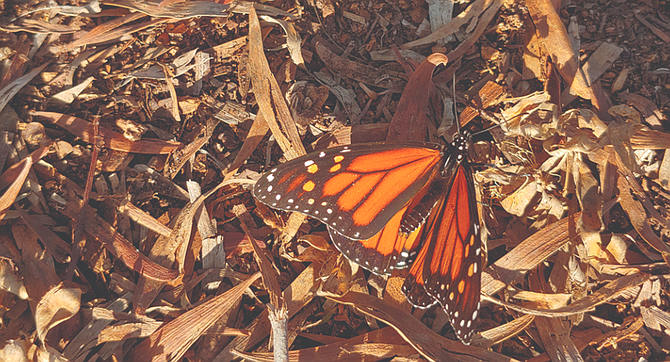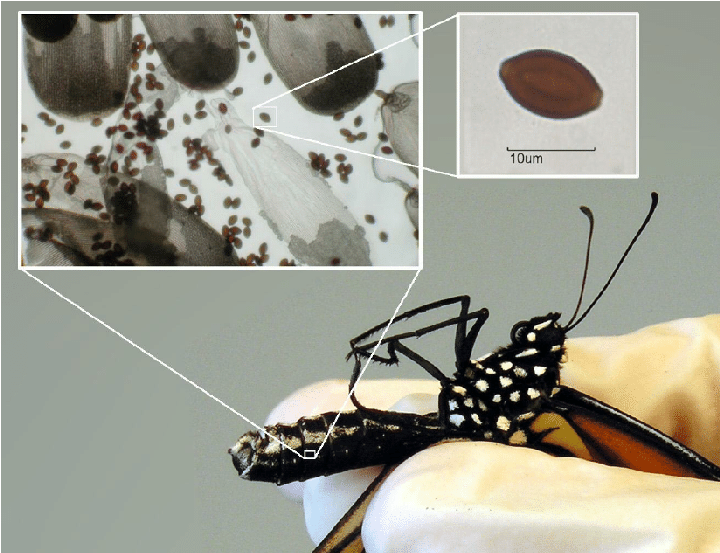 Facebook
Facebook
 X
X
 Instagram
Instagram
 TikTok
TikTok
 Youtube
Youtube

The monarch butterfly was added to the IUCN Red List as "now endangered" last month — for many reasons. The insect is eaten as an egg, caterpillar, chrysalis, or bright orange and black colored butterfly.
Other factors contribute to the monarch butterflies' decreasing numbers throughout San Diego County.
Experts say one of ten survives its cycle, and the numbers are worsening.
Lizette L., a former teacher, is guarding the two surviving monarch caterpillars in her North Park garden; she had ten until recently. One "succumbed to what I believe is the tachinid fly," she said. "I have about seven narrow leaves [milkweed] plants."
"The California Department of Food and Agriculture states that tropical milkweed has been designated a destructive weed," Lizette continued. "It reported that tropical milkweed is host to a protozoan parasite of monarch butterflies called Ophryocystis elektroscirrha, which are carried on adult monarchs as they migrate."

The milkweed plants in Lizette's garden are native and supposedly do not host the parasite.
But the tropical milkweed, sold and implemented by many San Diegans in their yards, is home to "dormant [parasite] spores and infect caterpillars that eat the plant," Lizette explained. "CDFA said that parasite infections have been linked to [the monarch butterflies'] lower migration success, reduction in body mass, lifespan, mating success, and flight ability."
Lizette adds there are more enemies of the monarch butterflies, "not just [the parasite]. It's so sad to witness the demise of these beautiful creatures. I'm going out to check on the last two caterpillars now."
Then there are birds and wasps flying around town seeking monarch butterflies.
An IB dweller added: "They (wasps) eat the caterpillars. The wasps are so bad this year. I keep the plants covered with burlap landscaping fabric, but a wasp found its way inside and killed one of my chrysalises."
Chrysalises are a stage of development before a monarch butterfly is still covered in a rigid casing before it becomes an adult insect with wings.
On August 15, I communicated with Sarah Crane; she protects the monarch caterpillars and butterflies in her San Diego yard. "You should see what white fly did to our garden," she said. "I spray Dawn dish soap water over the fence to kill them. These will be parasite free!"
Crane sprays the dish soap to rid the flies before they lay their eggs on monarch caterpillars, which can become hosts to the parasites. If she doesn't, the flies' larvae feed from inside the caterpillar and kill it, usually right before the caterpillar pupates.
Another factor causing local butterfly lovers to panic was because "monarchs arrived later this year versus last year," said Emily Sluiman from Moosa Creek Nursery in Valley Center. "The monarch butterfly [being] added to the IUCN Red-list will help bring awareness to their threat of extinction. The list is a way to encourage conservation and promote preserving our natural resources. With community awareness and action, we can bring forth change."
One change that local gardeners and butterfly lovers make is purchasing native milkweed plants, such as the narrow leaf milkweed plants Lizette planted in her North Park yard. Monarch butterflies can also live off nectar plants such as Yarrow (Achillea millefolium), Black Sage (Salvia mellifera), Coyote Mint (Monardella villosa), and Gumplant (Grindelia camporum) — added Sluiman.
While Moosa Creek Nursery is strictly wholesale, over 30 retail stores throughout southern California carry their brand of aforementioned plants for the monarch butterflies to live off.


The monarch butterfly was added to the IUCN Red List as "now endangered" last month — for many reasons. The insect is eaten as an egg, caterpillar, chrysalis, or bright orange and black colored butterfly.
Other factors contribute to the monarch butterflies' decreasing numbers throughout San Diego County.
Experts say one of ten survives its cycle, and the numbers are worsening.
Lizette L., a former teacher, is guarding the two surviving monarch caterpillars in her North Park garden; she had ten until recently. One "succumbed to what I believe is the tachinid fly," she said. "I have about seven narrow leaves [milkweed] plants."
"The California Department of Food and Agriculture states that tropical milkweed has been designated a destructive weed," Lizette continued. "It reported that tropical milkweed is host to a protozoan parasite of monarch butterflies called Ophryocystis elektroscirrha, which are carried on adult monarchs as they migrate."

The milkweed plants in Lizette's garden are native and supposedly do not host the parasite.
But the tropical milkweed, sold and implemented by many San Diegans in their yards, is home to "dormant [parasite] spores and infect caterpillars that eat the plant," Lizette explained. "CDFA said that parasite infections have been linked to [the monarch butterflies'] lower migration success, reduction in body mass, lifespan, mating success, and flight ability."
Lizette adds there are more enemies of the monarch butterflies, "not just [the parasite]. It's so sad to witness the demise of these beautiful creatures. I'm going out to check on the last two caterpillars now."
Then there are birds and wasps flying around town seeking monarch butterflies.
An IB dweller added: "They (wasps) eat the caterpillars. The wasps are so bad this year. I keep the plants covered with burlap landscaping fabric, but a wasp found its way inside and killed one of my chrysalises."
Chrysalises are a stage of development before a monarch butterfly is still covered in a rigid casing before it becomes an adult insect with wings.
On August 15, I communicated with Sarah Crane; she protects the monarch caterpillars and butterflies in her San Diego yard. "You should see what white fly did to our garden," she said. "I spray Dawn dish soap water over the fence to kill them. These will be parasite free!"
Crane sprays the dish soap to rid the flies before they lay their eggs on monarch caterpillars, which can become hosts to the parasites. If she doesn't, the flies' larvae feed from inside the caterpillar and kill it, usually right before the caterpillar pupates.
Another factor causing local butterfly lovers to panic was because "monarchs arrived later this year versus last year," said Emily Sluiman from Moosa Creek Nursery in Valley Center. "The monarch butterfly [being] added to the IUCN Red-list will help bring awareness to their threat of extinction. The list is a way to encourage conservation and promote preserving our natural resources. With community awareness and action, we can bring forth change."
One change that local gardeners and butterfly lovers make is purchasing native milkweed plants, such as the narrow leaf milkweed plants Lizette planted in her North Park yard. Monarch butterflies can also live off nectar plants such as Yarrow (Achillea millefolium), Black Sage (Salvia mellifera), Coyote Mint (Monardella villosa), and Gumplant (Grindelia camporum) — added Sluiman.
While Moosa Creek Nursery is strictly wholesale, over 30 retail stores throughout southern California carry their brand of aforementioned plants for the monarch butterflies to live off.
Comments